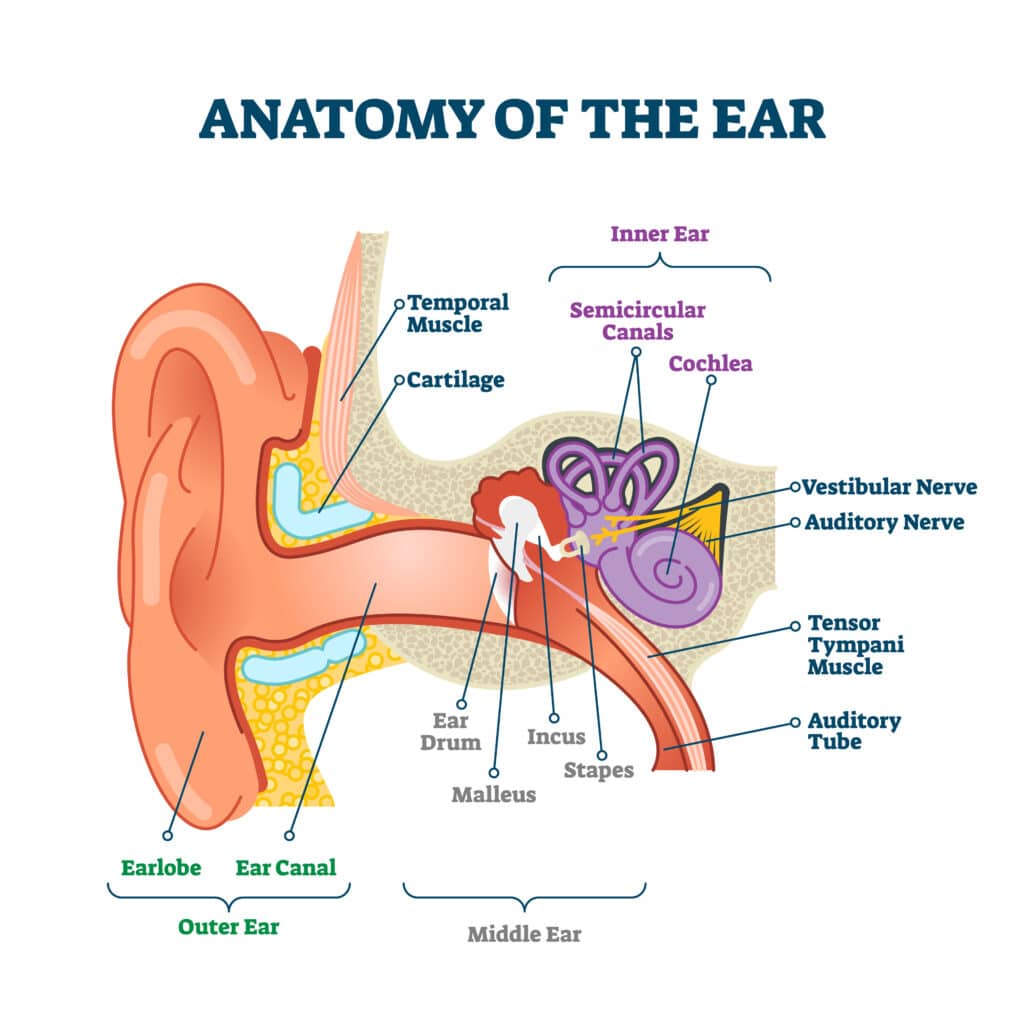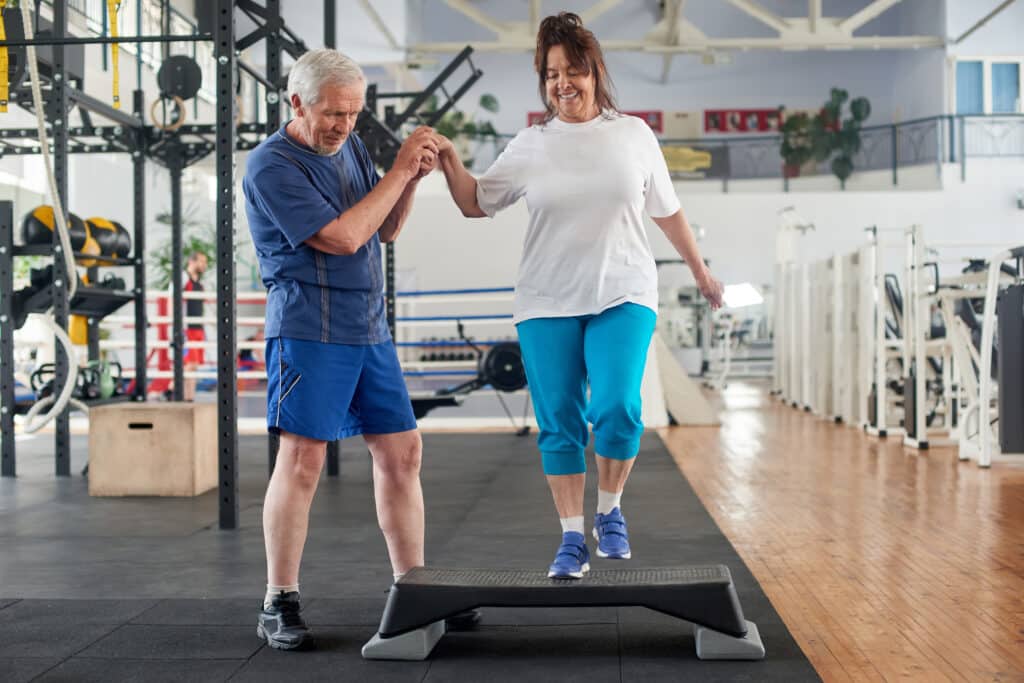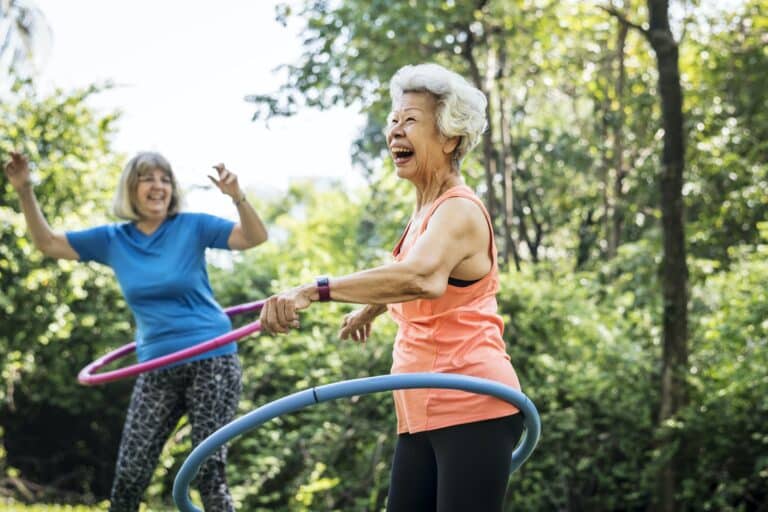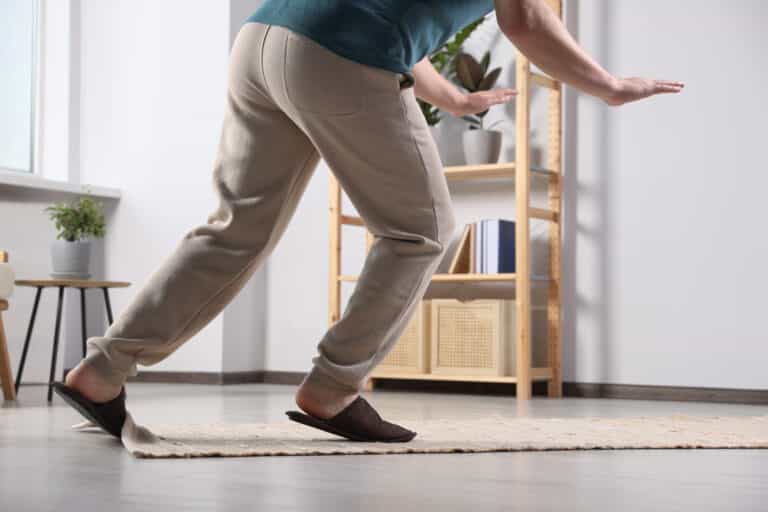When we think of balance, we often picture ourselves standing on one foot or walking in a straight line. But did you know that our balance is influenced by more than our ability to stand upright? It’s a complex process involving several body parts, including our brain and ears. Yes, you read that right! Our ears play a pivotal role in maintaining our balance.
Balance isn’t just about how well you can stand or walk. It’s a complex sensorimotor control system that relies on various sensory inputs, including vision, proprioception (awareness of the body’s position and movement), hearing, and vestibular function (the sense of balance we derive from our inner ear).
When we experience sensory impairment, such as hearing loss, can throw off our balance. Our brain uses the information from all these senses equally to help us stay upright and navigate our environment.
Let’s take a deeper look at how this crucial body system works.
A Brief Explanation of the Vestibular System

While ‘hearing’ and ‘balance’ are simple, the concepts of vestibular and auditory aren’t as straightforward. Let’s start with a breakdown of these seemingly complex terms and how they affect how you move through the world.
Vestibular vs. Auditory
The vestibular and auditory (hearing) systems are components of the inner ear and share a close anatomical and functional connection.
The vestibular system is primarily responsible for maintaining balance, spatial orientation, and coordinating eye movements. It consists of the vestibular organs, including the utricle, saccule, and three semicircular canals, which detect changes in head movement and position.
The auditory system, on the other hand, is responsible for processing sound. It includes the cochlea, a spiral-shaped organ in the inner ear, which converts sound vibrations into electrical signals that the brain interprets as sound.
The vestibular nerve—a branch of the vestibulocochlear nerve—connects the vestibular and auditory components to the brain. It plays a crucial role in transmitting signals related to balance and hearing.
While the vestibular system primarily governs balance and spatial orientation, it is closely interconnected with the auditory system through the vestibular nerve. This highlights the relationship between hearing and maintaining equilibrium. Issues affecting one system can often impact the other.
How Vestibular Problems Can Affect You

Understanding the dynamics of the vestibular system might seem complicated, but this simple analogy might help:
Imagine you’re on a merry-go-round. Even as the world spins around you, you can still focus your eyes on a fixed point. That’s the vestibular nerve in action!
It’s like a backstage director, coordinating eye and head movements to keep our vision stable and prevent us from feeling dizzy.
The Impact of Hearing Loss on Balance
Our sense of balance involves a delicate interplay between our eyes, inner ears, and brain. Imagine if one of these critical players—our ears—was compromised. How would it affect our ability to maintain balance and prevent falls?
I’ve often encountered this question in my practice, particularly with older patients experiencing hearing loss.
Research has shown that older adults with hearing loss are likelier to experience falls than those with normal hearing.1
How Hearing is Related to Fall Risk
Hearing loss can disrupt this sensorimotor system, impair processing time, cause slower reactions to external stimuli, and prevent you from preparing your body for danger.
Hearing loss can also be caused by an underlying condition, such as neuritis or inflammation in the inner ear, which can impact the vestibular system and one’s sense of position in space.
The vestibular system sends signals to the brain about head motion, helping us maintain our balance and stabilize our gaze. The auditory system works in tandem by listening out for signs of threat or danger so our body can prepare to react appropriately and stabilize to avoid injury.
For example, if a tumor or growth presses on your vestibular nerve, it can impact its ability to properly transmit these signals to the brain. If you were to experience this condition, you may be unable to get your bearings and likely feel unstable. On the auditory side, when experiencing something as simple as clogged ears or sudden-onset hearing loss, you may be less able to respond to environmental cues and, therefore, less able to anticipate stressors that can throw you off balance.
All these impacts on your overall function can manifest in a variety of balance issues and can even lead to falls.2
Understanding the link between the specific cause of hearing loss and any resulting balance impairments is paramount to safeguarding mobility and independence in later years.
A Patient’s Story About the Hearing and Balance Connection
In my practice, I’ve had several older patients who’ve experienced this first-hand. One such patient—let’s call him Mr. Johnson, an energetic 75-year-old—noticed a gradual increase in his instability and frequency of falls.
He couldn’t understand why since he was active and regularly attended his Tai Chi classes. However, we began to connect the dots when he mentioned his increasing hearing difficulty.
A series of tests confirmed that Mr. Johnson was experiencing sensorineural hearing loss. This type of hearing loss affects the ability to hear and negatively impacts the vestibular system.
With specific balance exercises and hearing aids, Mr. Johnson noticed a significant improvement in his balance and reduced falls, further highlighting the interconnection between hearing and balance.
Practical Exercises for Improved Balance

Loss of balance can lead to falls, which are a leading cause of injury and hospitalization in older adults. Thankfully, practical exercises can help improve balance. Here are a few exercises I regularly suggest for clients with vestibular issues.
Sit-to-Stand
Let’s start with an elementary exercise you can do while watching your favorite TV show: the sit-to-stand. It requires nothing but a chair and your attention.
- Sit comfortably in a chair with your feet flat on the floor and your spine upright.
- Try to stand up without using your hands. Avoid pushing the backs of your legs against the chair for leverage (hint: scoot forward on the chair so only your bottom is on the chair, not your thighs).
- Once standing, try to sit back down without using your hands.
Try to do this ten times, twice a day. As you get stronger and more comfortable, try doing it from a lower chair or a stair step if you feel confident that you can stand up from a low surface.
Heel-To-Toe Walk
This exercise is like walking on an imaginary tightrope. It’s a bit more challenging but excellent for improving balance and coordination.
- Position the heel of one foot just in front of the toes of the other foot. Your heel and toes should touch or almost touch.
- Choose a spot ahead of you and focus on it to keep you steady as you walk.
- Take a step. Put your heel just in front of the toe of your other foot.
- Repeat for 20 steps.
Note: Your physical therapist may recommend first performing this next to a counter or a handrail so that you can use your hand for balance support if needed.
Single Leg Balance
As simple as it seems, standing on one leg can take you a long way to regain balance with hearing impairments.
- Stand beside a chair, counter, or wall for added support.
- Lift one leg a few inches off the ground and take several deep breaths using the stable surface for minimal support.
- Once you feel fatigued in your standing leg, switch and try to spend an equal amount of time standing on the opposite leg.
- To advance the exercise, you can try it on a slightly unstable surface, like a folded towel. If you feel confident and comfortable with your support surface, you can also try closing your eyes.
Using a timer for any of these exercises, and increasing duration over time is a great way to monitor your progress.
These exercises may seem simple but can significantly affect your balance and overall mobility. Remember to listen to your body and not push too hard. With consistency, you will undoubtedly see improvement.
Always keep safety in mind when doing these exercises. If you feel dizzy or unstable at any time, stop the exercise. Consider having someone with you for support, especially when you first start these exercises. If any of these exercises cause pain, stop and consult with a healthcare professional. Remember, your safety is paramount.
Exercise to Enhance Balance
Regular exercise is a preventive measure against balance issues, strengthening the core and improving balance. Exercise for hearing loss can be as simple as standing on one leg or walking heel-to-toe—the exercises outlined above—or more structured, like yoga or pilates.
I’ve seen the benefits of these exercises in many of my patients.
For instance, Mrs. Jones, who was initially skeptical about exercise, started a gentle yoga program. Over time, she noticed a marked improvement in her balance, leading to increased confidence and fewer falls.
Seek Progress, Not Perfection
Improving balance is gradual, so don’t be discouraged if progress seems slow. Persistence is key!
A Journal of Clinical Medicine study emphasized the importance of consistent, long-term exercise for improving balance in older adults. So keep at it, and remember, you’re not alone on this journey.4
Fall Prevention Strategies for Older Adults
As the adage goes, prevention is better than cure. Regular check-ups are crucial in catching any early signs of hearing loss. My patients who get regular health check-ups tend to manage and prevent balance issues related to hearing loss better than those who don’t.
Regular Hearing Check-ups: The Key to Early Detection
Regular hearing check-ups are among the best ways to prevent hearing loss from affecting balance. They serve as an early warning system. If any hearing loss is detected, interventions can be implemented to help manage the condition before it significantly impacts balance.
In my experience, patients who have regular check-ups often have better outcomes. It is easier to implement a management plan with early detection. A care plan might include using hearing aids and balance exercises to maintain mobility and independence.
Healthy Lifestyle Choices
Prevention doesn’t stop at check-ups and exercise; it extends to all aspects of life. A healthy diet, avoiding excessive noise, and refraining from smoking can all help prevent hearing loss.
Taking preventive measures against hearing loss isn’t merely about preserving your hearing; it’s also about maintaining your balance, mobility, and overall lifestyle. So, remember, regular check-ups, balance-enhancing exercises, and healthy lifestyle choices are your best bet for staying on your feet and enjoying life.
What to Expect from a Plan of Care for Balance Issues
As an experienced medical practitioner, I’ve seen first-hand how hearing loss and balance issues can affect older adults. However, with a solid care plan, these conditions can be effectively managed and sometimes even improved. Let’s explore what a typical care plan might look like.
The most common intervention for hearing loss is the prescription of hearing aids. These devices amplify sound, making it easier for the individual to hear. Another popular strategy is auditory training, which involves exercises to improve the individual’s ability to interpret and understand sounds.
Conversely, balance issues often require a different approach. Physical therapy is generally the most effective intervention. The exercises involved help strengthen the muscles and improve the individual’s coordination. In some instances, medication may help to manage underlying vestibular conditions that contribute to balance problems, such as vertigo.
Effectiveness of the Interventions
Clinical studies have shown that these interventions can be highly effective. One study found that hearing aids and auditory training reduced a participant’s fall risk by an average of fifty percent.5
Similarly, physical therapy can significantly reduce the risk of falls, especially falls with injury, in older adults.
Ultimately, the effectiveness of a care plan depends on the individual’s specific needs and circumstances. Working with your healthcare provider to develop a plan tailored to you is essential. Each person’s journey is unique.
Hearing loss and balance issues can be challenging, but with the proper care plan in place, they don’t have to define your life.
Understanding the interventions available and their effectiveness can help you make informed decisions about your care. And always remember, you’re not alone in this journey—healthcare professionals are there to guide and support you every step of the way.
Summary
Understanding the connection between hearing loss and balance issues is vital for prevention and effective care. Regular hearing checks, maintaining an active lifestyle, and promptly addressing hearing loss can help mitigate the risk of balance issues and falls.
Losing your hearing doesn’t just affect your ability to listen to your favorite music or have a conversation. It can shake your whole world—quite literally. So, let’s pay attention to our ears—they do much more than just hearing; they help us stay upright and prevent potentially harmful falls.
Key Takeaways
- Balance involves more than just physical stability; it requires the intricate interplay of the brain, ears, and sensory systems, including vision and proprioception.
- The vestibular and auditory systems within the inner ear are closely connected and play critical roles in maintaining balance and processing sound.
- Vestibular problems and hearing loss can significantly affect balance, potentially leading to increased fall risks, especially in older adults.
- Practical exercises like sit-to-stand, heel-to-toe walk, and single-leg balance can markedly improve balance and reduce the risk of falling.
- Regular hearing check-ups and addressing hearing loss early through interventions like hearing aids can help manage balance issues and maintain independence.
- A comprehensive approach, including regular exercise, healthy lifestyle choices, and medical interventions, is key to managing balance and hearing-related issues effectively.
References
- Lin, F. R., & Ferrucci, L. (2012). Hearing loss and falls among older adults in the United States. Archives of internal medicine, 172(4), 369–371. https://doi.org/10.1001/archinternmed.2011.728
- Agrawal, Y., Carey, J. P., Della Santina, C. C., Schubert, M. C., & Minor, L. B. (2009). Disorders of balance and vestibular function in US adults: data from the National Health and Nutrition Examination Survey, 2001-2004. Archives of internal medicine, 169(10), 938–944. https://doi.org/10.1001/archinternmed.2009.66
- Brodie, A., Smith, B., & Ray, J. (2018). The impact of rehabilitation on quality of life after hearing loss: a systematic review. European archives of oto-rhino-laryngology : official journal of the European Federation of Oto-Rhino-Laryngological Societies (EUFOS): affiliated with the German Society for Oto-Rhino-Laryngology – Head and Neck Surgery, 275(10), 2435–2440. https://doi.org/10.1007/s00405-018-5100-7
- Papalia, G. F., Papalia, R., Diaz Balzani, L. A., Torre, G., Zampogna, B., Vasta, S., Fossati, C., Alifano, A. M., & Denaro, V. (2020). The Effects of Physical Exercise on Balance and Prevention of Falls in Older People: A Systematic Review and Meta-Analysis. Journal of clinical medicine, 9(8), 2595. https://doi.org/10.3390/jcm9082595
- Campos, L., Prochazka, A., Anderson, M., Kaizer, A., Foster, C., & Hullar, T. (2023). Consistent hearing aid use is associated with lower fall prevalence and risk in older adults with hearing loss. Journal of the American Geriatrics Society, 71(10), 3163–3171. https://doi.org/10.1111/jgs.18461






